WEEKLY WATCH
WEEKLY WATCH
OPINION
Control Targets
Of all cities’ property price control targets, Beijing’s is the first to declare its market is “stable and dropping” and it is likely to be the only one realizing price reductions.
The State Council issued an eight-point regulation in January instructing local governments to establish and announce new house price control targets in the first quarter of the year.
The announced targets were, to a large extent, tied to local GDP performance and per-capita disposable incomes, and many cities set targets at around 10 percent.
For most people, even if current prices are cut by 10 to 20 percent, houses will still be unaffordable, let alone if there is 10 percent growth rate.
Housing prices in China are no longer a problem solely of the economy but are gradually growing into a social issue. The Central Government has thus decided to curb the rocketing prices that have long irritated the public.
The new eight-point regulation, which has been considered one of the “most severe measures” in history, initially gave people big hopes of decreasing housing prices.
To cut property prices is not easy, but it does not mean it’s unattainable. Thanks to the severe eight-point regulation, speculative investments are dropping. This can be seen in the sharp drop in house transactions since the regulation was issued. Meanwhile, the housing supply to low-income families is increasing. Factors favorable to price reduction are accumulating. Beijing’s reduction targets confirm the possibility of the state’s control aims. What matters is government’s, especially local governments’, determination.
People’s Daily
Earth Hour
Communities, enterprises and universities in China’s 86 cities participated in Earth Hour on March 26, an energy-saving event initiated by the World Wildlife Fund (WWF).
The public’s wish to save energy and protect environment is great, but the campaign itself is not immune from criticism. For example, when turning off the lights, some people lit candles to pray for the world. The problem here is the cost of a candle is higher than an hour’s lighting from electric power. At the same time, candle burning produces a lot of carbon dioxide.
It’s true turning off lights for only an hour doesn’t save too much electricity and few people expect to realize low-carbon targets depending on this campaign. But Earth Hour is more a symbolic suggestion than a tangible energy-saving action.
As the theme of this year’s Earth Hour campaign says: Turn off the lights and let’s make the change, apart from the hour, just making the change itself is important. Government should take the lead in saving energy; enterprises ought to fulfill environmental protection obligations by creating energy-saving technologies; and individuals also need to save energy in their daily lives.
Xinmin Evening News
Government Building
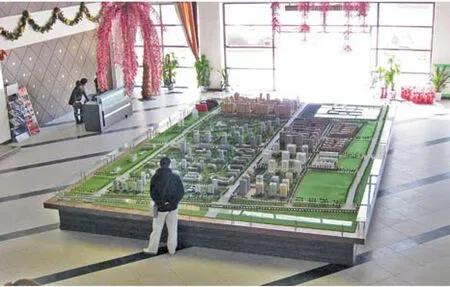
PROPERTY MARKET DIPS: Since Beijing began to enforce a restriction on home purchases, house transactions have been in a sharp decline. The capital city has also set up a price reduction policy
The government office building of Wangjiang County, Anhui Province, which is under construction, covers 12.1 hectares of land and exceeds the scale of eight White Houses. In response to criticism, a local joint investigation panel said the construction area has not exceeded standards for size, but problems did exist, which are imperfect project approval procedures and excessive interior decoration.
The fact Wangjiang is an impoverished county makes the construction of a sizable and luxurious government building out of sync. What is more surprising is the local authority’s claim it is not exceeding the size standard.
The relevant regulations issued in January 2009 set the average floor area for offices for county-level officials at 20 square meters, and officials at lower levels are to possess smaller areas. The floor area of Wangjiang’s office building amounts to more than 40,000 square meters, which will be able to accommodate more than 2,000 countylevel officials.
Although the investigation panel points out deficiencies in the estimation and appraisal procedure of the building project and the excessive decoration of building, it still is trying to play down the issue. Such an investigation is really questionable.
Beijing News
Tomb Sweeping
Tomb sweeping is the Chinese nation’s long tradition to show respect and commemoration of their ancestors during the Tomb Sweeping Festival, which usually falls around April 5. The Central Government has also designated a legal holiday for the festival.
But more and more problems seem to have emerged during the festival. Every year, tens of thousands of tons of paper is burned as a sacrificial offering for the dead in front of tombs. Apart from the waste of resources, paper burning may also cause fires. The movement of flocks of people also causes traffic jams, among other problems.
There are many different ways. Instead of burning paper, putting flowers on the tombs is a good alternative. To use flowers as a sacrificial offering will not hurt even a little of the people’s wish to express commemoration and respect for the dead. And the festival will move in a more environment-friendly direction.
Nowadays, it’s not even necessary for people to go personally to cemeteries. They may try “online tomb sweeping,” or they may choose to go to cemeteries on different days to avoid crowded traffic during the festival.
Accepting new methods will enable tomb sweeping to become more environmentally friendly and allow it to keep pace with modern society.
Xinmin Evening News
SOCIETY
Back From Expedition
China’s 27th Antarctic expedition arrived in Shanghai on April 1, wrapping up a 142-day expedition to ice-covered Antarctic.
Researchers completed 31 scientific research missions, 25 logistical assignments and an international collaborative project while dealing with the continent’s harsh weather conditions.
Seismic observation, ozone monitoring and studies of Antarctic land formations were among the scientific missions conducted there.
The 190-member research team began its expedition on November 11, 2010, when they set out from the southern Chinese city of Shenzhen.
Flood Prevention
The State Council approved on April 6 an overall plan to further harness China’s small and medium-sized rivers and reinforce dilapidated reservoirs to prevent large, floodtriggered geological disasters.
Over the next five years, China will address prominent problems in more than 5,000 small and medium-sized rivers with a minimum drainage area of 200 square km each, 300 large and medium-sized dilapidated reservoirs as well as 20,000 small ones.
Measures will also be taken to improve the conditions of more than 2,000 large and medium-sized dilapidated water gates as well as the conditions of protective embankments and flood storage and retention areas in Dongting and Poyang lakes in the south.
Road Safety
China kicked off a three-month road safety campaign on April 1, following a spate of deadly accidents in March.
Police authorities will set up temporary checkpoints along highways and expressways to monitor hazardous moves such as overloading, says a statement issued by the Ministry of Public Security.
Companies operating long-distance coaches, city buses and tourist vehicles that are found to have safety risks will have to suspend business until the risks are eliminated or their licenses will be revoked, says the statement.
Four fatal road accidents occurred from March 11 to 16, killing 66 people and injuring 87 others respectively in Xinjiang Uygur Autonomous Region, Tibet Autonomous Region, and Shanxi and Jilin provinces.
Projects in Xinjiang
Xinjiang Uygur Autonomous Region in northwest China started construction of 17 reservoirs and a water diversion project on April 2.
The projects will cost 1.44 billion yuan ($220 million) and have a total storage capacity of more than 95 million cubic meters. They are expected to help more than 17,000 nomadic households settle down by increasing and improving 107,000 hectares of irrigated areas after their completion in the winter of 2012.
Xinjiang has nearly 1.23 million herdsmen, 60 percent of whom move from place to place due to difficult living conditions. The improvement in water supply would enable nomads to engage in animal husbandry and farming to increase their income, said a spokesman with Xinjiang’s water resources department.
Space Mission
China’s second lunar orbiterChang’e-2has achieved all goals and will carry out further research operations, said the State Administration of Science, Technology and Industry for National Defense on April 1.
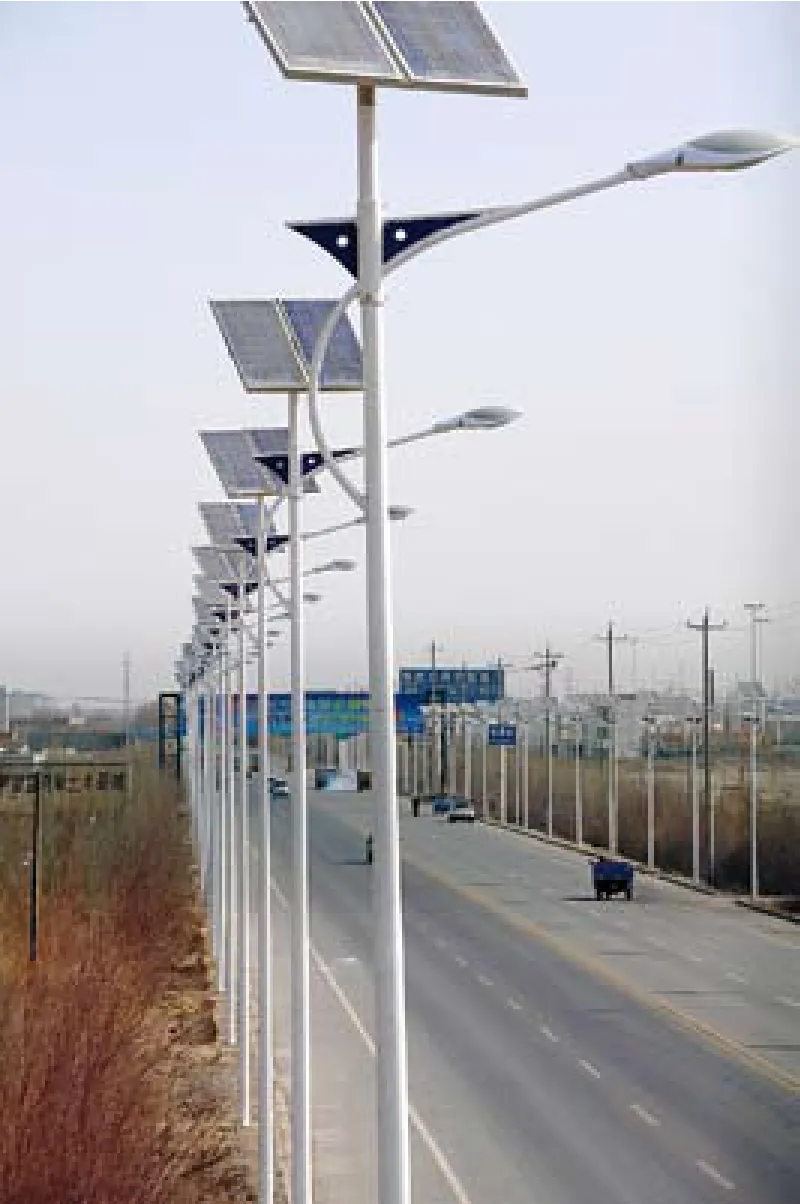
MODERN CITY The solar-powered street lamps in Golmud, northwest China’s Qinghai Province, are a sign of the fast development of the transportation hub on Qinghai-Tibet highway and railway
According to a statement of the administration, operations ofChang’e-2remained normal after 180 days in space.
The solar-powered probe was launched on October 1, 2010, to collect information for a moon-landing. It entered its long-term lunar orbit on November 3 and has collected a great amount of scientific data.
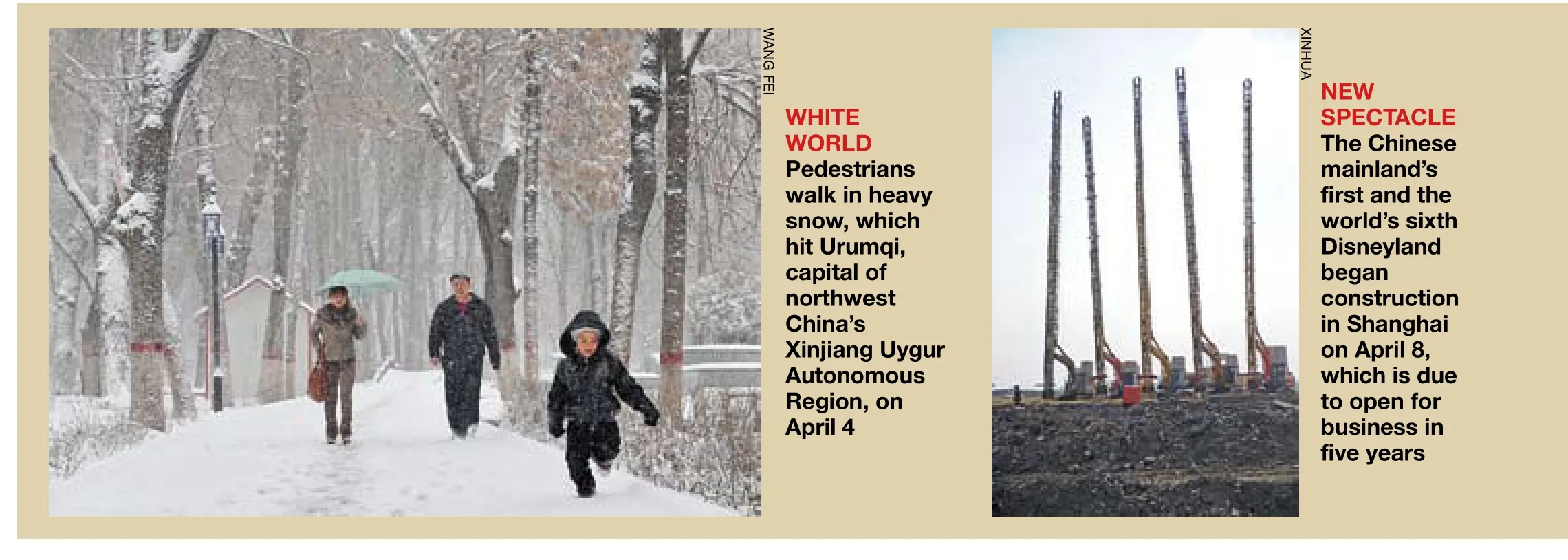
ECONOMY
Economic Trend
China’s economy is expected to grow 9.6 percent in 2011, even as inflation remains a threat for Asia’s growth engine as well as other economies in the region, the Asian Development Bank (ADB) said in its 2011 Asian Development Outlook report released on April 6.
With inflation pressures building and tightened monetary policy, China’s GDP growth is forecasted to be moderate this year, compared with a growth of 10.3 percent in 2010, said the ADB, which expected a growth of 9.2 percent in China in 2012.
The inflation rate, which averaged 3.3 percent in 2010, may pick up to 4.6 percent in 2011, lifted by abundant liquidity and higher food and commodities prices. ADB estimated the inflation will ease back to 4.2 percent in 2012.
Poultry Imports
China on April 2 ordered a ban on imports of poultry products from the Zeeland Province of the Netherlands where an outbreak of H7N1 bird flu virus was reported on March 22, said the General Administration of Quality Supervision, Inspection and Quarantine and the Ministry of Agriculture.
Any poultry and poultry products mailed or carried by tourists from the Netherlands will be returned or destroyed. Poultry and poultry products, if found from the European country on ships, flights or trains that stop in China, will be sealed off from other products to prevent contamination.
Rare Earth Profits
The Inner Mongolia Baotou Steel Rare-Earth (Group) Hi-Tech Co., China’s leading rare earth producer, said on April 6, its net profit reached a record high of 750.74 million yuan ($114.6 million) in 2010 due to rising rare earth prices.
The company’s net profit was 55.77 million yuan ($8.52 million) in 2009.
The company attributed the profit surge to higher prices of rare earth products and the government’s policies for promoting the development of the rare earth industry.
The company said its business revenue totaled 5.26 billion yuan ($803.79 million) last year, a year-on-year increase of 102.78 percent from 2009.
Hong Kong Property
The Hong Kong Land Registry announced that the number of sale and purchase agreements for all building units received for registration in March was 13,501, up 8.9 percent over February and 6.3 percent year on year.
Among the sale and purchase agreements, 10,456 were for residential units, up 0.6 percent over February, but down 3.7 percent compared with March 2010.
The sale and purchase agreements were valued at about HK$69.4 billion ($8.92 billion), up 26 percent month on month and 19.4 percent year on year.
Western Fair
The 12th Western China International Fair will be held on October18-22 in Chengdu, capital of southwestern Sichuan Province, to promote industry transfer and introduce new projects to west China.
The fair will cover more than 12,000 square meters with six exhibition halls. The latest technological achievements and products, including 3D technology and intelligent machines, will be the focus of the fair, said Mu Xinhai, Secretary General of the Western China International Fair.
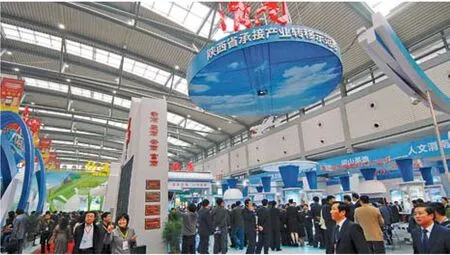
ECONOMIC TIE-UP The 15th Investment & Trade Forum for Cooperation Between East & West China opened on April 6 in Xi’an, capital of Shaanxi Province, attracting more than 5,700 foreign visitors. This year’s forum aims to deepen economic cooperation between eastern and western regions and propel prosperity in west China
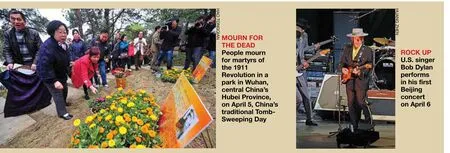
1. SWITZERLAND
Dai Zhendong, a professor with China’s Nanjing University of Aeronautics and Astronautics, holds a lizard, the main test animal of a system crucial to the development of robots at a Geneva exhibition on April 6
2. JAPAN
Ikuhiro Hattori (first left), Chairman of Japan’s National Federation of Fishery Cooperative Associations, protests in Tokyo on April 6 against the Tokyo Electric Power Co.’s decision to discharge radioactive waste water into the sea
3. THE UNITED STATES
Chefs prepare vegetarian meals to advocate healthy lifestyles and environmental protection during the New York City Vegetarian Food Festival on April 3
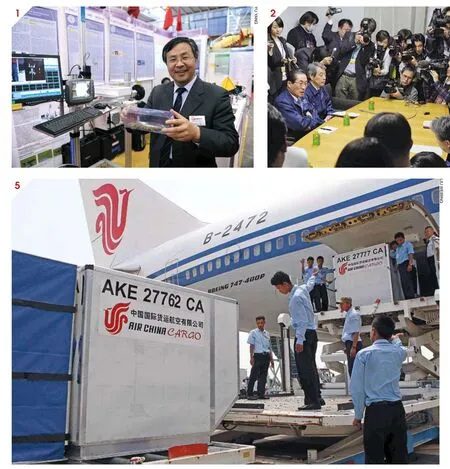
4. KAZAKHSTAN
A Russian spacecraft named after the first cosmonaut Yuri Gagarin takes off at the Baikonur Cosmodrome in Kazakhstan on April 5, carrying three astronauts to the International Space Station
5. MYANMAR
Workers unload containers of medicine from Chinese top political advisor Jia Qinglin’s plane in Mandalay on April 2. Jia arrived for an official visit, bringing with him relief materials for Myanmar’s quake-hit areas
6. THAILAND
Floodwaters submerge fields and houses in Surat Thani Province on April 4. As of that day, floods in southern Thailand had killed 51 people

